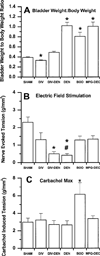Hypertrophy changes the muscarinic receptor subtype mediating bladder contraction from M3 toward M2
- PMID: 12763741
- PMCID: PMC3277086
- DOI: 10.1152/ajpregu.00009.2003
Hypertrophy changes the muscarinic receptor subtype mediating bladder contraction from M3 toward M2
Abstract
Major pelvic ganglion electrocautery (MPGE) and spinal cord injury in the rat induce bladder hypertrophy and a change in muscarinic receptor subtypes mediating bladder contraction from predominantly M3 to a combination of M2 and M3. To determine whether this is a result of bladder hypertrophy or denervation, we studied the following groups: sham-operated controls, urinary diversion (DIV), MPGE together with urinary diversion (DIV-DEN), bilateral MPGE (DEN), bladder outlet obstruction (BOO), and MPG decentralization (MPGDEC). The degree of bladder denervation was determined by the maximal carbachol response normalized to the response to electric field stimulation. Receptor subtype density was determined by immunoprecipitation. The affinity of subtype-selective muscarinic antagonists for inhibition of carbachol-induced contractions was used to determine the subtype-mediating contraction. DEN, MPG-DEC, and BOO bladders were hypertrophic whereas DIV bladders were atrophic compared with sham operated. Bladder contraction in sham-operated, DIV, and DIV-DEN was mediated by the M3 receptor subtype, whereas the M2 subtype participated in contraction in the DEN, MPG-DEC, and BOO groups. The hypertrophied bladders had an increase in total and M2 receptor density while all experimental groups showed a reduction in M3 receptor density. Thus bladder hypertrophy, independent from bladder denervation, causes a shift in the muscarinic receptor subtype mediating bladder contraction from M3 toward M2.
Figures





Similar articles
-
Regulation of bladder muscarinic receptor subtypes by experimental pathologies.Auton Autacoid Pharmacol. 2006 Jul;26(3):311-25. doi: 10.1111/j.1474-8673.2006.00377.x. Auton Autacoid Pharmacol. 2006. PMID: 16879497 Free PMC article.
-
M2 receptors in genito-urinary smooth muscle pathology.Life Sci. 1999;64(6-7):429-36. doi: 10.1016/s0024-3205(98)00582-7. Life Sci. 1999. PMID: 10069506 Free PMC article.
-
Muscarinic receptor transcript and protein density in hypertrophied and atrophied rat urinary bladder.Neurourol Urodyn. 2006;25(1):55-61. doi: 10.1002/nau.20180. Neurourol Urodyn. 2006. PMID: 16304675 Free PMC article.
-
On the muscarinic receptors in the urinary bladder and the putative subclassification of muscarinic receptors.Acta Pharmacol Toxicol (Copenh). 1986;59 Suppl 1:1-45. Acta Pharmacol Toxicol (Copenh). 1986. PMID: 3524114 Review.
-
Muscarinic receptor subtypes modulating smooth muscle contractility in the urinary bladder.Life Sci. 1999;64(6-7):419-28. doi: 10.1016/s0024-3205(98)00581-5. Life Sci. 1999. PMID: 10069505 Review.
Cited by
-
β3-Adrenoceptor Agonist Effects on the Urinary Bladder Beyond Detrusor Relaxation.Neurourol Urodyn. 2025 Sep;44(7):1498-1502. doi: 10.1002/nau.70043. Epub 2025 Mar 31. Neurourol Urodyn. 2025. PMID: 40159930 Free PMC article. Review.
-
Changes in the muscarinic receptors on the colonic smooth muscles of rats with spinal cord injury.Ann Rehabil Med. 2011 Oct;35(5):589-98. doi: 10.5535/arm.2011.35.5.589. Epub 2011 Oct 31. Ann Rehabil Med. 2011. PMID: 22506180 Free PMC article.
-
The use of occupation isoboles for analysis of a response mediated by two receptors: M2 and M3 muscarinic receptor subtype-induced mouse stomach contractions.J Pharmacol Exp Ther. 2008 Jun;325(3):954-60. doi: 10.1124/jpet.108.137018. Epub 2008 Mar 13. J Pharmacol Exp Ther. 2008. PMID: 18339971 Free PMC article.
-
Gastric body cholinergic contractile signal transduction in M2 and M3 receptor knockout mice.J Recept Signal Transduct Res. 2013 Aug;33(4):249-54. doi: 10.3109/10799893.2013.802803. Epub 2013 Jun 20. J Recept Signal Transduct Res. 2013. PMID: 23786223 Free PMC article.
-
Nerve transfer for restoration of lower motor neuron-lesioned bladder function. Part 1: attenuation of purinergic bladder smooth muscle contractions.Am J Physiol Regul Integr Comp Physiol. 2021 Jun 1;320(6):R885-R896. doi: 10.1152/ajpregu.00299.2020. Epub 2021 Mar 24. Am J Physiol Regul Integr Comp Physiol. 2021. PMID: 33759578 Free PMC article.
References
-
- Braverman AS, Bartula LL, Myers SI, Parkman HP, Ruggieri MR. Inflammation changes the muscarinic receptor subtype and signal transduction pathway that mediates gallbladder contraction. Gastroenterology. 2000;118:A197.
Publication types
MeSH terms
Substances
Grants and funding
LinkOut - more resources
Full Text Sources
Research Materials

